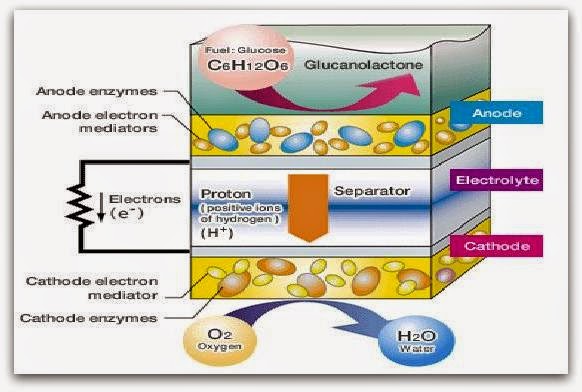Bio Battery
How The Bio Battery Works
Glucose is broken down on the anode side of the battery, producing protons (H+) and electrons (e-). The protons (H+) are transferred to the cathode side through the separator, while the electrons (e-) are transported to the cathode side through the mediator, which transfers them to the external circuit. The cathode uses the enzymes to drive an oxygen-reduction reaction which ultimately produces water using both the protons (H+) and the electrons (e-) transferred from the anode. These reactions at the anode and cathode generate electric energy by creating proton (H+) and electron (e-) flow in the cell system.
Previous Attempts Of Bio-Fuel Cells
Several potential applications of BFCs have been reported or proposed in the literature for implantable devices, remote sensing and communication devices as a sustainable and renewable power source. However, there are no BFC design formats or templates that allow for the production of a working device with a size on the order of 1 cc, which are needed for several "real world" applications. An enzyme based BFC is very attractive, however it has been shown that electron flow is too slow to make a viable fuel cell. This is due to the difficulty for enzymes to attain direct electrical contact with the electrodes of the cell and catalyze reactions effectively. The two largest obstacles with bio-fuel cells which must be overcome are increasing the power density and increasing the enzyme stability.

About
Energy (obtained from food through enzymatic reactions) is the basis of human movement. Enzymes are special proteins that facilitate chemical reactions inside our bodies. Sony's Bio Battery uses this same principle to produce electric energy. It is an extremely safe form of energy production since the fuel (glucose) is a carbohydrate just like bread or rice. Because glucose is a clean energy source---produced by plants through photosynthesis (a process that involves the absorption of CO2) ---Bio Battery is also an eco-battery.
The Mechanism Behind Bio Battery
Like a conventional fuel cell battery, Bio Battery basically consists of an anode, cathode, electrolyte and separator. However, Bio Battery has certain specific characteristics. First, biological enzymes are used as catalysts for the anode and cathode. Second, enzymes and electronic mediators (which transfer electrons between enzymes, and between enzymes and electrodes) are fixed on the anode and cathode.
Abstract
Bio-fuel cells are alternative energy devises based on bioelectrocatalysis of natural substrates by enzymes or microorganisms. Here we review bio-fuel cells and bio-batteries based on the recent literature. In general, the bio-fuel cells are classified based on the type of electron transfer; mediated electron transfer and direct electron transfer or electronic charge transfer (ECT). The ECT of the bio-fuel cells is critically reviewed and a variety of possible applications is considered.
Packaging Of Bio-Fuel Cells
One of the major challenges in bionanotechnology is merging new nanoscale fabrication tools with classical synthetic methods and delicate biomolecular building blocks to create materials with unique biomedical properties. In order to address the packaging requirement of the bio- fuel cells, it will be necessary to bridge the disciplines of biology, chemistry, materials science, semiconductor technology and engineering to find optimum packaging solutions for the challenges posed by these devices. Biological packaging can be defined as the sum total of the physical device, temperature regulating and monitoring systems, type of preservation solution, and storage protocol(s) necessary to maintain cells or tissues in a "state of suspended animation" during transport or storage.
Conclusion
Bio-fuel cells are energy-conversion devises based on bio-electro catalysis leveraging on enzymes or microorganisms. Chemical reactions can proceed by direct electron transfer (DET), in which case the electron transfer occurs directly between enzymes and electrodes,5 or through shuttle mediated electron transfer (MET), in which electron transfer mediators shuttle the electron between enzymes and electrodes to reduce the kinetic barrier in the electron transfer between enzymes and electrodes. Direct electron transfer (DET) is desirable for efficient communication between enzymes and electrodes, and eliminating the need for mediators may simplify the construction of bio-fuel cells.
Source: https://www.seminarppt.in/2014/05/bio-battery.html
Posted by: dariusdariuslevene0273577.blogspot.com